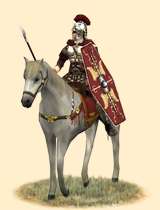Eqvites Singvlares (Picked General's Guard Cavalry)
 |
Weapons | Defence | Mental | ||||||
|---|---|---|---|---|---|---|---|---|---|
| Primary | Secondary | Armour: | 13 | Morale: | 16 | ||||
| Type: | spear | sword | Shield: | 4 | Discipline: | disciplined | |||
| Attack: | 4 | 13 | Skill: | 11 | Training: | highly_trained | |||
| Charge: | 30 | 15 | Recruitment | Other | |||||
| Lethality: | 0.33 | 0.13 | Soldiers: | 10 | Hit Points: | 1 | |||
| Range: | 0 | 0 | Cost: | 1783 | Mass: | 1 | |||
| Ammo: | 0 | 0 | Upkeep: | 0 | |||||
| Turns: | 1 | ||||||||

Equites Singulares are provincial horse guards formed with the best horsemen a regional army has to offer and accompany their commanders into battle.
Equites Singulares are provincial horse guards formed with the best horsemen a regional army has to offer and accompany their commanders into battle. These units are mostly equipped and fight in the manner of normal Roman cavalry. However, sometimes better or additional armour, such as greaves, are worn, that most times are even more highly elaborated than in the ordinary Alae. Besides their body armour, the horsemen of the equites singulares wear iron helmets and long oval or hexagonal shields for protection, while every rider is armed with either a type Mainz gladius or Celtic style longsword, ancestors of the spatha, the first real roman cavalry sword, a hasta lance and several iacula, light javelins. Like most of the imperial army’s cavalry, they use the famous four horned saddle, which enables a firm seat in almost all occasions. In battle the equites singulares often proved to be one of the most powerful units. When a capable general leads them personally they can turn the fight in critical moments.
Historically, from the early Principate onwards, imperial governors, who normally also commanded all the military stationed in their province, were protected by their own horse guards, mostly raised from the regular alae units in the local army. Contrary to the men selected for the later equites singulares augusti, these picked horsemen remained in the lists of their original units and were only temporarily transferred to the guards.
During the decades of his rule following the end of the civil war, Augustus reformed the imperial army significantly and created a standing army with 28 legions as its core. In many fields a systematic approach replaced the improvisation of the late republican era. Most important was that the auxilia, with its indispensable cavalry and archer units, became a regular arm of the professional army and its second base.
Trained to the same high standards of the legions they should cooperate with, these excellent soldiers were equipped in the Roman fashion, and well commanded first by proven Centurions, transferred from the legions, and later by a corps of equestrian officers. Their soldiers were mostly recruited from amongst the peregrines, free provincials without roman citizenship, who either volunteered for service or accepted a draft into it. However, the transformation of the auxilia did not happen over night and the irregular contingents of soldiers supplied by allied tribes and vassal states did not disappear all at once. While the large majority of the alae (pure cavalry units where the need for regular forces was more urgent) were reorganized during Augustus reign, the infantry followed much more slowly, lingering in the old fashions until the later years of the 1st century AD.
The length of service for all soldiers was finally set to 26 years for fleet soldiers, 25 years for soldiers of the auxilia, 20 years for legionnaires, and 16 years for praetorians. After their discharge they received a cash bonus, the praemia militare, or a small piece of land. The veterans from the auxilia and the fleet were rewarded with Roman citizenship, and a diploma to prove it. Also, medical treatment was improved and all units were now supplied with physicians.